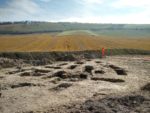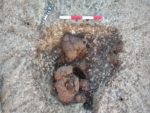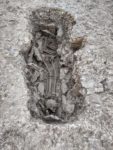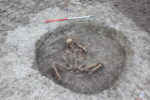 Excavations at the site of a water pipe installation have discovered 26 ancient skeletons, some from the Iron Age with unusual burial practices that suggest a ritual purpose. The new water pipes are being installed near Wantage in Oxfordshire to protect Letcombe Brook, a rare chalk stream in the Vale of White Horse which has been under environmentally damaging pressure from the water needs of agriculture and population.
Excavations at the site of a water pipe installation have discovered 26 ancient skeletons, some from the Iron Age with unusual burial practices that suggest a ritual purpose. The new water pipes are being installed near Wantage in Oxfordshire to protect Letcombe Brook, a rare chalk stream in the Vale of White Horse which has been under environmentally damaging pressure from the water needs of agriculture and population.
 With the Uffington White Horse, the iconic Iron Age chalk hill figure, just five miles away, the site was archaeologically surveyed before the pipe installation. Contractors Cotswold Archaeology excavated several sites in the area where the 3.7 miles of pipe were set to be laid. They unearthed 26 individual burials dating from the Iron Age and the Roman period. They also found the remains of animals, household objects, pottery, cutting tools and one comb.
With the Uffington White Horse, the iconic Iron Age chalk hill figure, just five miles away, the site was archaeologically surveyed before the pipe installation. Contractors Cotswold Archaeology excavated several sites in the area where the 3.7 miles of pipe were set to be laid. They unearthed 26 individual burials dating from the Iron Age and the Roman period. They also found the remains of animals, household objects, pottery, cutting tools and one comb.
 Unusually for the period, the Iron Age skeletons were buried in pits. There are very few surviving graves from this time, between two and three thousand years ago, because many of the Iron Age communities in the area are believed to have practiced a form of sky burial in which bodies are placed in the open air to decompose courtesy of the elements and scavenging animals. Some of the pit burials featured peculiar body placement, a head between the feet, for example, and feet relocated to the upper body. Iron Age pit burials appear to have had a ritual purpose, and previous discoveries show evidence of bones having been exhumed at later dates.
Unusually for the period, the Iron Age skeletons were buried in pits. There are very few surviving graves from this time, between two and three thousand years ago, because many of the Iron Age communities in the area are believed to have practiced a form of sky burial in which bodies are placed in the open air to decompose courtesy of the elements and scavenging animals. Some of the pit burials featured peculiar body placement, a head between the feet, for example, and feet relocated to the upper body. Iron Age pit burials appear to have had a ritual purpose, and previous discoveries show evidence of bones having been exhumed at later dates.
“The Iron Age site at Childrey Warren was particularly fascinating as it provided a glimpse into the beliefs and superstitions of people living in Oxfordshire before the Roman conquest. Evidence elsewhere suggests that burials in pits might have involved human sacrifice.
Paolo Guarino, Cotswold Archaeology project officer, added: “These findings open a unique window into the lives and deaths of communities we often know only for their monumental buildings, such as hillforts or the Uffington White Horse.
“The results from the analysis of the artefacts, animal bones, the human skeletons and the soil samples will help us add some important information to the history of the communities that occupied these lands so many years ago.”
 The human remains and archaeological material have been removed from the site by Cotswold Archaeology. They will be examined in laboratory conditions while Thames Water lays the new pipes which will supply groundwater taken from the Thames to neighboring villages thereby preserving Letcombe Brook’s unique ecosystem.
The human remains and archaeological material have been removed from the site by Cotswold Archaeology. They will be examined in laboratory conditions while Thames Water lays the new pipes which will supply groundwater taken from the Thames to neighboring villages thereby preserving Letcombe Brook’s unique ecosystem.
The problem with iron age and earlier burials is that the older the burial, the less chance of anything recognisable as a burial surviving, especially as it is much harder to find their settlements in the first place.